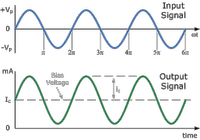At the outset I want to make it very clear that I dont want to get into any extended argument for or against Amplifier Burn-in. However, I certainly want to offer a set of reasons why I am so skeptical about amplifier burn-in. When I think through it logically, it does not make any sense to me. Mind you, when an amplifier is used for a period of time, it certainly will have some impact on its performance. What we are discussing here, though, is the statement made by a number of people that, after 100 odd hours of use, an amplifier will actually belt out
better sound due top some inexplicable reason.
Asit, Cranky and others have made some comments that got me thinking seriously. Frankly, in all my life, I have heard a different sound from the same system only once. This was in an exhibition where I was hungrily listening to a pair of B&W DM303. When I came back the next day, my favourite singer - OS Arun - sounded more life like. However, I have my doubts whether it was due to burn-in of any component or because the exhibitor had changed some units in the system, specially the speaker cables.
Last few weeks I have been listening to a Music Hall A25.2 amplifier, which I got unopened. I have used that amp for over 6 weeks, and the music sounded great to me from day one until I had to return the amp. I had purposely used the same CDs a number of times through the 6 weeks, carefully listening for any change in tonality or any other characteristic of the music and, as I said, they sounded the same. I did not change any component including cables, interconnects, CD player, or, speakers. I can say this with some confidence as I listened mainly to singers such as Katie Melua, Harry Belafonte and, The Dave Brubeck Quartet. With these artists, the sheer simplicity of the songs helps you in immediately catching any changes in the tone or other characteristics of the song,
Long ago, I had assembled my own amplifier using kits from a now defunct British company called Bi-Amp Kits. This was a fully populated board and all I needed to do was to fit it in a cabinet and fix knobs to the pots. Excepting for an initial pop during power on, the system sounded divine. I had this connected to a Dual 606 with Ortofons Concorde cartridge, and a pair of humongous speakers assembled by me and my friend using 10 inch woofers, mid range and, Philips tweeters. The cross over, again, was a fully assembled kit imported from Britain. I had a set of LPs that I used again and again including the then just released The Wall by Pink Floyd. I remember putting my ears very close to the speakers to hear every bell and every helicopter sound from that album. Again, I remember the system sounding the same throughout the two odd years that I used it.
So when someone says that an amplifier sounds better after it is used, what am I missing? Have I gone deaf? Have I become incapable of recognizing subtle differences in music? What was I doing when I auditioned the Audire system, and more recently, the Lyritas? Was I dreaming when I clearly remember why a friend of mine (an audiophile himself) called the Hsu Research subwoofer liquidy, as it had a very fast decay and we could easily identify multiple low frequency sounds individually without any overhang or rollover? Was I dreaming when I could hear the laboured breathing of a dog in The Gladiator with just the change of a pair of speakers? Mind you, I never listen to music or watch a movie at anything greater than 50 to 60 dB at between 8 to 10 feet from the speakers.
There are numerous arguments on the burn-in effect on cables, interconnects, and even players. But, an amplifier? If nearly all the items of a system are so undependable that we have to burn them in and pray to God that they will sound nice, why are we paying kings ransom for all these high fidelity equipment? Would a designer agree that the specifications that he used to design an amplifier circuit would last only for a few hours of use? More important, how would he agree to the statement that his circuit would
somehow sound better after 100 hours of use? What control does he have on the behaviour of his design during those 100 hours or even after?
If a manufacturer or a dealer tells me that I must use the system for 100 hours before it sounds nice, I will have just one answer. Run it yourself for 100 hours and give it me
if it sounds better. I can at least save 100 hours of warranty.
As I said, this got me thinking, and I decided to understand how an amplifier circuit works and what could possibly change in the circuit. As Julie Andrews sings in the Sound of Music, let us start at the very beginning.
An audio amplifier has two major parts.
The first part is a power unit that has a power transformer, a rectifier, filter, capacitors, and a voltage regulator. The power unit supplies the requisite DC voltages to the next unit in the amplifier chain the amplifier circuit. The regulated power supply is usually bypassed with high quality capacitors. These are placed next to the supplied circuit and electrically between the power supply rail, and the ground. The capacitor provides a path to ground the noises from the power supply unit. There have been some discussions on the capacitors used before and after the power unit. To not complicate matters for now, we will assume that we are able to supply stable and noise free voltages to the amplifier circuit. However, do keep in mind that we will come back to the power unit later.
There are multiple ways of building an amplifier circuit tubes, op-amps, MOSFETS, JFET, ICs, and others. What we will be discussing, for easy understanding, is a simple discrete transistor based amplifier.
The most important part of the amplifier is the transistor. The transistor is a solid-state semi conductor that has three elements: the
base,
emitter, and the
collector. The transistor converts a small signal at the base to a large signal at the collector. Think of it as a hosepipe carrying water. The water source is the emitter, and the base is a tap in the hose that opens and closes to allow more or less water to flow. Remember, I said more or less, not
on or off. In other words, a transistor always has
some current flowing through it. You will understand the importance of this further down.
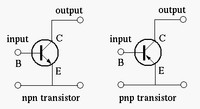
Before we move forward let us understand what we need from an amplifier. An analogue music signal is a pure sine wave as shown in the figure below. At a particular frequency, a sine wave will sound smooth and pleasant to our ears. If at the same frequency, the sound carries an additional wave, this will become noise to our ears. This additional wave is called
harmonics.
Essentially, we need an identical duplicate of the original sine wave (input signal) to be given to us as an output signal. The amplifier must faithfully reproduce the input signal with perfect bias, never reaching its cut-off or saturation points. This will give us a signal that is perfectly centered between the amplifiers upper and lower limits as shown above. We will be discussing bias a little below.
Let us look at a single transistor amplifier to understand how the signal is amplified.
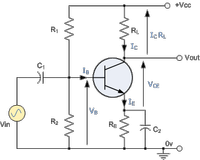
In the figure above, the object in the central grey circle is an NPN transistor. Other supporting devices such as resistors (R1, R2) and capacitors (C1, C2) surround the transistor.
The DC power supply is connected to the collector at top of the transistor as shown above (+Vcc). The emitter is at ground potential, meaning it is negative with respect to the collector. As a voltage exists between the collector and the emitter, the current will want to flow through the transistor. The base can either allow or deny the current from flowing depending upon the base voltage. Thus, the base acts as a control valve. When the transistor is turned on by a tiny amount of base current, a large current flows from the emitter to the collector. When it is turned off by a lower base current, no current flows between the emitter and the collector.
If we insert an audio signal on the base, it will control the current flow from the emitter to the collector. When the amplitude of audio signal is more, the transistor will be turned on more, allowing more current to flow from the emitter to the collector. A low amplitude audio signal will allow less current to flow through the transistor. This is how an audio signal is amplified. This is also why the volume control is always with the pre-amplifer, as that is the unit that sends the audio signal to the base of the amplifiers transistor.
The quantum of amplification provided by the transistor is called gain. This is expressed either as a ratio between the input and output voltages or in decibels (dB). A gain of 10 means that the input signal has been amplified 10 times. A 1Khz sine wave with a base voltage of 10mV will, when amplified with a gain of 10, produces a 1KHz sine wave of 100mV.
Real life is always more difficult and never follows theory to the T. A transistor can never be turned off completely. A small base current is always present. This is called the bias current and is essential to make the transistor work. Bias makes the transistor conduct quiescent current through the collector when there is no input signal at all. Quiescent means being at rest or being dormant.
The amount of bias current is very carefully selected so that the transistor always operates within its linear operating region.
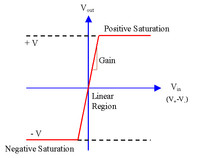
Bias allows the amplifier to amplify both positive and negative phases of the audio signal. As the supply voltage is positive and the emitter is connected to the ground, the transistor can never produce a negative voltage at the collector.
Bias sets the zero crossing point at some voltage between the ground and the supply voltage the designer thinks is optimal for the amplifier to work with minimal distortion.
This is determined by the values of the emitter and collector resistors. The quiescent Base voltage (Vb) is determined by the potential divider network formed by the resistors R1 and R2, and the power supply voltage Vcc, and, this is given as Vb=Vcc*R2/R1+R2. This base voltage should not be affected by any external factor, as that will immediately introduce distortion. A pair of what are called coupling capacitors - C1 and C2 - take care of this.
These will pass only AC signals and block any DC component that could alter the bias.
Some designers do not like to use capacitors in the audio path. This kind of circuit is called
direct coupled. DC can yet be prevented from reaching the output with a device called
DC Servo.
The large signal at the output is simply a DC power supply converted to AC audio signal by the transistor. What does this mean? This means that the power supply is effectively
always in the path of the audio signal. Both the audio signal and the power supply are connected to the collector. Thus, anything that happens to the power supply noise, high impedance, fluctuations all could affect the audio signal. This also has bearing in what my conclusions are at the bottom.
DISTORTION
One of the major problems with all amplifiers is that, because of the very nature of their operation, they can never reproduce a duplicate of the original signal. They add some signals of their own, and these are called distortion. The most difficult part of an amplifier design is to reduce distortion as much as possible. There are multiple types of distortion and we will understand them briefly now.
In
Harmonic Distortion, an overtone is added to the base frequency of the input signal. If an input signal is a 100Hz pure sinewave, the output will contain the 100Hz sinewave, plus a 100Hz harmonics, a 200Hz harmonics, a 300Hz harmonics and so on. These are called the first, second, third harmonics, and so on. In the picture below, the figure on the left shows the input frequencies, while the right shows the distorted signals output by the amp.

Harmonics distortion is expressed as a percentage of the input. The term
Total Harmonic Distortion (THD) is something we are all familiar with. If an amplifier outputs 10V and the harmonic distortion additions are 10mV, the amplifier has a THD of 0.1%. A high second order or third order distortion is more acceptable to the human ear than even a low sixth or seventh order distortion.
Another distortion is called
Inter Modular Distortion or IMD. If you feed two frequencies as input at the same time, the output signal will have these two frequencies, plus the sum and differences of these frequencies. For example, if you feed a 100Hz and a 10KHz signal, the output will contain these two plus a 9.9KHz signal (the difference) as well as a 10.1KHz signal (the sum). IMD is, in layman terms, referred to as muddiness or lack of definition. Severe IMD could lead to audible artifacts sounds that were never there in the source in the first place.
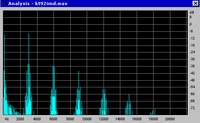
In the picture above, the amplifier has been fed with a 100Hz and a 3000Hz signal and asked to amplify to a peak level of 1 watt. The tall peak is the 3000Hz input signal. As you can see, it is straddled by a whole set of other signals created by IMD.
Next, if a transistors bias, or quiescent Base voltage changes, the amplifier will stop being linear and result in
Amplitude Distortion.
If the bias is low, output waveform will have its negative part of the output waveform chopped off. If the bias is high, the positive part gets chopped. Why does this happen? Simple, actually. When the bias voltage is small, during the negative part of the cycle, the transistor does not conduct the voltage fully so the output is set by the supply voltage. When the bias is large, the positive part of the cycle saturates the transistor and the output drops almost to zero. Look at the figure below.
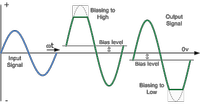
There is another distortion that is kind of extension to amplitude distortion. Even if the biasing voltage is set correctly, a large input signal could get distorted when amplified. The output waveform gets chopped off on both positive and negative ends and no longer look like a sine wave. This is called
Clipping and happens when the input circuit is stretched or over driven. I have been warning people of this in many threads, particularly of connecting an iPod or similar device that has a tiny amplifier of its own. This takes the input signal of the amplifier beyond its specified limits and immediately introduces distortion. Remember, the amplitude control is with the preamplifier, so what you feed into it is very important.
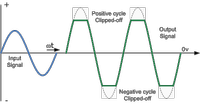
We now come to another distortion that is very important for our discussion. This is called
slew-rate, phase, or
delay distortion. If the steepness of the input signals attack is faster than the ability of the amplifier to amplify the signal, then slew-rate limiting will occur. An amplifiers slew rate is measured in volts per microsecond (V/s). This describes how much voltage an amplifier can swing in a specified time period. If the input signals transients are faster than this, the amplifier will distort the musics structure, This is also sometimes referred to as the amplifiers speed.
To understand this better look at the following figure:

For an amplifier to work without any slew rate, it must be able to deliver a specified amplitude at the steepest slope of the input wave as shown by the dark line above. Though the input sine wave has negative and positive signals as it passes through zero, the magnitude of change is always nearly identical in both cases.
An amplifiers slew rate is determined by the storage and discharge capacities of the capacitors used as these can only handle a finite amount of current. For an amplifier to pass a sine wave with no distortion, its slew rate must meet or exceed the highest rate of change of the input wave represented by the steepest slope. Why not make an amplifier with very high slew rate? This will require a speaker cone to stop instantly and move in the other direction. So, even if you can construct such as an amp, there is no speaker on earth that can deliver that kind of slew rate.
What we have discussed till now is the configuration of a Class A amplifier. The other classes are B, A/B, C, and D.
A Class D amplifier uses integrated circuits. Such amplifiers are usually very well protected internally because of the construction methodology and have error corrections modes. The chances of such amplifier changing their behaviour pattern are very remote.
Most of the amplifiers used for audio are either Class A or Class B. A Class A amplifier is very inefficient and is power hungry. As against a single transistor in Class A, Class B amps use two complementary transistors in what is called a push-pull configuration.

A phase splitter divides the input signal into two halves. The positive half is fed to a transistor that operates in a NPN configuration. The negative half is fed to the complementary transistor that operates in the PNP configuration. The two output amplified halves are assembled to deliver a full signal. As against the Class A where there is always a quiescent Base voltage, in Class B, when one transistor is operating, the other transistor is switched off. This is more efficient as there is less power consumption as well as less heat generated. Of course there is a catch, and that is called
Crossover Distortion. If the two halves of the signal are not biased perfectly, crossover distortion happens. When one transistor does not switch on exactly when the other is switching off, the two halves of the output curve may have differences in amplitude as well as differences in terms of the point at which they meet on the X-Axis.

Most amplifiers operate as Class A up to a particular amplification level, then switch to Class B beyond that. Such amplifiers are called Class A/B. The point at which the switch happens is determined by three factors:
1. The amount of bias current the Class A transistor can handle
2. The amount of heat the transistor generates
3. The amount of current the power supply can handle.
REMOVING DISTORTION
Can distortion or errors in the amplifier circuit be removed completely? No, that is not possible. However, they certainly can be reduced to a very large extent. One method to do this is called
feedback. In this, a portion of the output is taken from the collector and fed back to the emitter. Amplifiers may also work in multiple stages of amplification. When output from one or more of the intermediate stages is fed back to the input, this is called
local feedback. When output from the final stage is fed back, this is called
global feedback.
CONCLUSIONS
What have we learnt till now? An amplifier is, by nature, an unstable device. In addition, amplifiers work on very small margins as far as input and their internal circuitry go. The input, for example, is usually in the 1 to 3 volt range, and increments for amplifications are in small fractions.
Many designers do not believe in feedback and work carefully on every part of the amplifier so as to not create errors in the first place. The amplifier works in a narrow bandwidth of tolerances or margins. If these margins are crossed in either direction, the immediate action of the amplifier is to start distorting the input signal. The higher the output power, the more are the chances for the amplifier to start distorting.
Design goals are generally high slew rate, high bandwidth, low output impedance, and high current capabilities. This means large power units, very carefully chosen parts, and parts of the highest quality possible at the price point. Most of the factors we discussed above are specified by standard mathematical formulas. The designer will use these formulas to calculate the specifications of all the supporting devices for a particular transistor that he uses.
One of the biggest issues with transistors (and associated devices) is heat. As large amounts of current pass through them constantly, all units in the amplifier and, the transistors in particular, will heat up. This is called warm up and takes roughly 30 to 120 minutes.
What happens when a transistor heats up? A number of things:
1. The current between the collector and base increases. Its flow through the biasing resistors drives the base more positive, increasing forward bias on the base-emitter diode. This means immediate amplitude distortion.
2. The emitter voltage required for a given collector voltage will decrease. This means unwarranted increase in the gain of the transistor.
3. If the current flowing through the system is kept constant, the resistance of the devices will increase with temperature. This will lead to a loss of power and further increase in temperature. If this is not controlled, the temperatures at the junctions will rise till the devices are destroyed.
The designer has to take these into consideration. He will measure the performance of the amplifier after the warm up, and relook at his specifications. A prototype will be constructed and used extensively for performance measurements across time and usage. The measurements will be given back to the designer to bring on as much stability as possible to the amplifier.
Specifications of supporting devices such as resistors and capacitors cannot be allowed to change as this will junk the very design of the amplifier. In addition, the manufacturer has to work with the specifications supplied by the manufacturer of these devices. As a designer, I will not even touch, say, a resistor if the manufacturer tells me its specification are valid only for the first 100 hours of usage. The manufacturers of such devices will specify something like a mean time between failures (MTBF). This is the time in the products life cycle when it is expected to meet its manufactured specifications without any change. Since all these devices will generate heat, the manufacturer will also specify the temperature limits within which the device will deliver according to its specifications.
Thus, as long as the specified temperature limits are maintained and a stable power is supplied, 100, 200 or 300 hours of use should not make nor develop any difference to the specification of the amplifier devices. The minute any of the specifications change, distortion will set in. Of course, this could happen when inferior parts are used, but this then becomes a design and construction flaw.
A reputed manufacturer will burn-in a prototype system for such time as he thinks is enough to alter the system specification
adversely. He will then measure the specifications of the devices and, if some of them have changed, replace them with parts that are more reliable or with parts that have different specifications.
Since the amplifier devices work within extremely narrow margins and with high current flow, any minute change in the specifications can only affect the amplifier adversely. If there were any possibility of positive improvement in performance, this would already have been considered by the designer. Remember, a designer will want his design to be tested to near destruction point so that he can get the best operating performance possible. It is very rare that a random and uncontrolled factor such as 100 hours of usage could affect the amplifier in a
positive way.
So what does happen that make people say that their amplifiers sound better after usage? There is one possibility and this relates more to the power unit.
There is a lot of copper used in the power unit for flow of current. Asit had once explained that the conductivity of copper increases after current flows through it for some time. Essentially the molecules inside the copper align themselves in the direction of flow. This reduces internal resistance within the copper and aids in the smoother flow of current. The power unit will, thus, after some usage, be able to deliver marginally higher current, and more important, the higher current faster. This will affect the amplifier circuit in two ways. One, the amplifiers slew rate will improve enabling the amplifier to match the input signals speed better. Two, the power unit will be able to replenish the capacitors faster, thus enabling the amplifier to attack the next rush requirement with equal gusto. The net effect will be that, to our human ears, the music will sound smoother.
A well designed amplifier, in my opinion, will, with usage, not have any positive change in tonality, headroom, dynamics, or other similar and important characteristics of the sound signal. The only possible positive change is the increase in the slew rate and the resultant attack speed of the amplifier.
Let me try to clarify a point raised by Asit. He wanted me to scientifically explain why a couple of hours of usage would make a difference and not 100 hours or 200 hours. This is the difference between warm-up and burn-in that I have explained above. Because of current flow, an amplifier will reach very near it max operating temperature quite quickly. This, as I explained above, does have an effect on its performance. In addition, the designer is working with specifications given to him about the operating temperature of the various devices he is using. He will thus be able to take this into consideration during design stage.
But burn-in is different. What we are all saying is that something unknown happens to the state or the very matter of the devices used that make them perform better. Unlike friction in mechanical devices, electronic devices, as I mentioned above, are designed to deliver consistent results for a specified time called MTBF. A resistor, for example, will always allow a certain voltage (V) to flow for a given resistance (R) and current (I) as per the equation V=IR. As long as you supply the correct current, you can expect the resistor to provide a
consistent resistance and supply the voltage you expect it to for something like 50,000 hours (MTBF). Yes, they do have some more parameters such as tolerance, temperature coefficient, noise, and inductance. But, all these are factors known to the designer of the amplifier when he chooses a resistor. These are the specifications supplied by the manufacturer. What we are expecting is that these specifications change somehow and that is why the amplifier starts behaving differently. My point is that these specifications
cannot be allowed to change, and if they dont, the amplifiers behavior also cannot change. If these specification do change, the part has
failed to operate according to its specification, and that change
can never have a
positive impact on the whole unit. It can only be negative in the form of distortion given the small tolerances within which we operate. If the change is small enough to be within the specified tolerances, the result will be so minute that it will have no effect on our listening pattern.
Cheers
Acknowledgements:
1.
The Complete Guide To High End Audio by Robert Harley
2.
Audio Technology Fundamentals by Alan A. Cohen
3. Most images from
Introduction to Amplifiers



